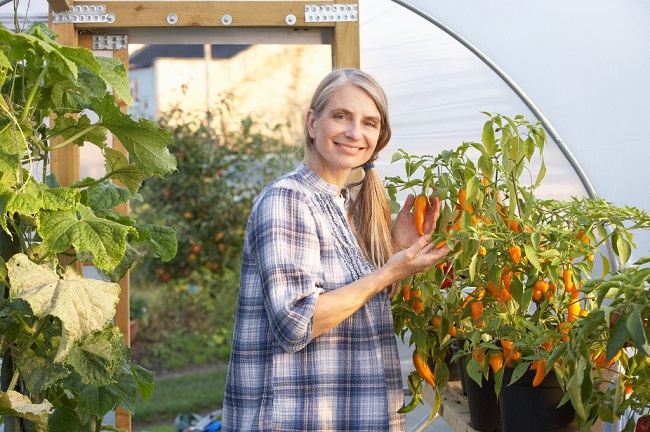Several varieties of vegetables can be grown and harvested in a greenhouse during the coldest part of the season without the use of toxic chemicals. They can be raised in a small greenhouse for your own use and in larger greenhouses to sell to local customers. Since growth rates slow as temperatures drop, plants need to be started early enough to reach maturity by the harvest date. Some varieties require additional light during short winter days for the onset of fruit. Seed companies can provide you with this information and lights can be installed when needed.

Most varieties of lettuce, spinach, chard, broccoli, carrots, turnips, and other cold-tolerant plants will continue to grow right through the winter in a closed greenhouse. When the temperature is below freezing outside, heat from the sun (including many cloudy days) will raise temperatures inside well above freezing. Keeping night temperatures at or just above freezing will allow cold tolerant plants to continue to grow.
My area, Southeastern Ohio, is located between zones 5 and 6 and cold-tolerant plants will grow through the winter with a little additional heat. Adding plant blankets and double plastic covers will reduce or eliminate the need for additional heat. The hardiest plants, including several varieties of greens, can tolerate temperatures as low as 25ºF–28ºF with little or no damage to the plant. This article recommends several plant varieties for winter greenhouses and nighttime temperatures below freezing.
I avoid growing tomatoes, peppers, squash, and other heat-loving vegetables during the two coldest months, because of the high cost of fuel. Their plants, however, can be started during these months in a well-insulated, well-lighted germination chamber or on well-lighted shelves in your house and can then be transplanted into the greenhouse in March and April for early crops.
Germinating seeds yourself will provide you with healthy plants of the exact varieties you need on the desired dates. Seeds of tomato, cucumber, broccoli, squash, and most common garden varieties will germinate within 4–8 days in temperatures between 70°F–80°F. Pepper seeds take a little longer and prefer warmer temperatures, 75°F–85°F. The seeds of most salad greens, onions, and herbs will germinate between 60°F–70°F.
Any mixture of finely chopped peat moss, perlite, vermiculate, and a complete nutrient fertilizer will provide good germination in packs and continued growth in containers. My favorite all purpose fertilizer is Peters 20-20-20.
Plants grown in containers can be moved when desired. Those in raised beds may be high enough to make planting and care easier on your back. I prefer to transplant into the soil of the greenhouse floor. Before transplanting, add manure and organic matter to the greenhouse soil. Whatever methods are used to prepare a rich and fertile garden for your soil-type, can be used for your greenhouse. The soil is covered with a woven, porous polypropylene fabric, which allows water to penetrate, prevents weed growth, and reduces disease and insect problems. The black color of the fabric absorbs heat from the sun, adding warmth to the soil. A small hole is cut in the ground cover for each plant. For me, transplanting in the floor of the greenhouse is easier, maximizes production space, and saves time. It also saves the expense of containers, fertilizer, and the growing medium.
Cold, from the ground outside, will penetrate the greenhouse through the soil. For small greenhouses an insulating barrier can be installed under greenhouse walls to keep greenhouse soil warmer. Cold tolerant plants, especially salad greens, don’t seem to mind, if the ground stays above freezing. In my 2,500 square-foot greenhouse, lettuce, spinach, peas, parsley, and chard, planted near the walls, keep growing without an insulating barrier as long as inside temperatures remain above 32°F.
If you want to raise tomatoes, peppers, beans, cucumbers, and other warm-weather plants during the coldest part of the winter, a nighttime temperature of 40°F–50°F must be maintained for optimum plant growth and daytime temperatures should be around 60ºF or higher. To save on fuel costs, these varieties should be located as far as possible from the outside walls of the greenhouse and enclosed in small tent-like covers (for a few plants) or double insulated areas (for larger crops). Heat that leaks through the cover will raise the temperature of the rest of the greenhouse where cold-tolerant plants will benefit.
Growing vegetables and harvesting them through the winter provides high-quality food for your own table and crops to sell at a time when few local vegetables are available. Small greenhouse owners can sell extra produce to neighbors and friends directly from the greenhouse. Larger producers can find interest among farmers’ market customers and the managers of cooperatives and locally owned grocery stores and restaurants.
Gini Coover is the author of The Natural Greenhouse, Growing Plants and Food for Profit. She has grown greenhouse plants and vegetables for over 30 years.
Related Articles & Free Email Newsletter
15 Ways to Make Your Greenhouse More Efficient
How to Heat a Greenhouse Without Electricity




Comment here